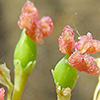Populus euphratica (Euphrates Poplar) is a weird tree – it carries leaves with two shapes on the same individual: some of its leaves are lanceolate, elongated, like the leaves of Salix acmophylla or Eucalyptus camaldulensis (River Red gum) and their margins are entire; and some are as broad as they are long, with a round, rhomboid or triangular contour, and are sometimes dentate. The tree reaches a height of 3-8 meters. The trunk is twisted. The leaves turn yellow and are shed in winter. It is dioecious, and each individual carries flowers of one sex only, either male or female.
Euphrates Poplar blooms from February to April. Its flowers are tiny, arranged in inflorescences, pollinated by wind even though they have nectaries. The seed carries a white pappus, which helps in its dispersion by wind.
Euphrates poplar grows in humid habitats in warm deserts, mainly in the lower Jordan Valley and in the Dead Sea Valley. It comprises an important component in the thickets of Geon Hayarden. Its global distribution spreads from western East Africa to Central Asia.
Written by Mike Livne





